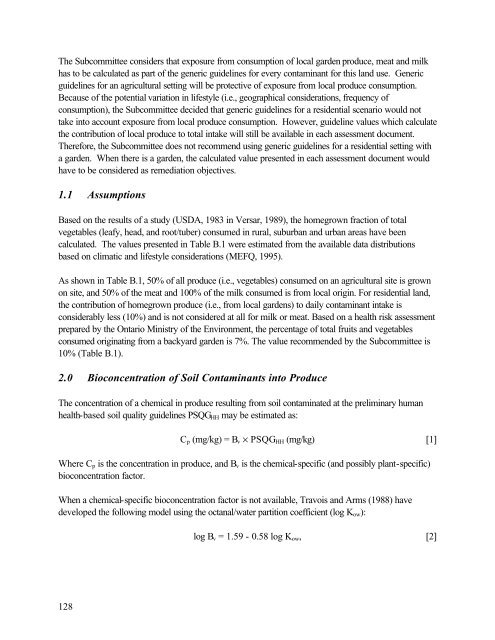Protocol for the Derivation of Environmental and Human ... - CCME
Protocol for the Derivation of Environmental and Human ... - CCME
Protocol for the Derivation of Environmental and Human ... - CCME
You also want an ePaper? Increase the reach of your titles
YUMPU automatically turns print PDFs into web optimized ePapers that Google loves.
The Subcommittee considers that exposure from consumption <strong>of</strong> local garden produce, meat <strong>and</strong> milk<br />
has to be calculated as part <strong>of</strong> <strong>the</strong> generic guidelines <strong>for</strong> every contaminant <strong>for</strong> this l<strong>and</strong> use. Generic<br />
guidelines <strong>for</strong> an agricultural setting will be protective <strong>of</strong> exposure from local produce consumption.<br />
Because <strong>of</strong> <strong>the</strong> potential variation in lifestyle (i.e., geographical considerations, frequency <strong>of</strong><br />
consumption), <strong>the</strong> Subcommittee decided that generic guidelines <strong>for</strong> a residential scenario would not<br />
take into account exposure from local produce consumption. However, guideline values which calculate<br />
<strong>the</strong> contribution <strong>of</strong> local produce to total intake will still be available in each assessment document.<br />
There<strong>for</strong>e, <strong>the</strong> Subcommittee does not recommend using generic guidelines <strong>for</strong> a residential setting with<br />
a garden. When <strong>the</strong>re is a garden, <strong>the</strong> calculated value presented in each assessment document would<br />
have to be considered as remediation objectives.<br />
1.1 Assumptions<br />
Based on <strong>the</strong> results <strong>of</strong> a study (USDA, 1983 in Versar, 1989), <strong>the</strong> homegrown fraction <strong>of</strong> total<br />
vegetables (leafy, head, <strong>and</strong> root/tuber) consumed in rural, suburban <strong>and</strong> urban areas have been<br />
calculated. The values presented in Table B.1 were estimated from <strong>the</strong> available data distributions<br />
based on climatic <strong>and</strong> lifestyle considerations (MEFQ, 1995).<br />
As shown in Table B.1, 50% <strong>of</strong> all produce (i.e., vegetables) consumed on an agricultural site is grown<br />
on site, <strong>and</strong> 50% <strong>of</strong> <strong>the</strong> meat <strong>and</strong> 100% <strong>of</strong> <strong>the</strong> milk consumed is from local origin. For residential l<strong>and</strong>,<br />
<strong>the</strong> contribution <strong>of</strong> homegrown produce (i.e., from local gardens) to daily contaminant intake is<br />
considerably less (10%) <strong>and</strong> is not considered at all <strong>for</strong> milk or meat. Based on a health risk assessment<br />
prepared by <strong>the</strong> Ontario Ministry <strong>of</strong> <strong>the</strong> Environment, <strong>the</strong> percentage <strong>of</strong> total fruits <strong>and</strong> vegetables<br />
consumed originating from a backyard garden is 7%. The value recommended by <strong>the</strong> Subcommittee is<br />
10% (Table B.1).<br />
2.0 Bioconcentration <strong>of</strong> Soil Contaminants into Produce<br />
The concentration <strong>of</strong> a chemical in produce resulting from soil contaminated at <strong>the</strong> preliminary human<br />
health-based soil quality guidelines PSQG HH may be estimated as:<br />
C p (mg/kg) = B v × PSQG HH (mg/kg) [1]<br />
Where C p is <strong>the</strong> concentration in produce, <strong>and</strong> B v is <strong>the</strong> chemical-specific (<strong>and</strong> possibly plant-specific)<br />
bioconcentration factor.<br />
When a chemical-specific bioconcentration factor is not available, Travois <strong>and</strong> Arms (1988) have<br />
developed <strong>the</strong> following model using <strong>the</strong> octanal/water partition coefficient (log K ow ):<br />
log B v = 1.59 - 0.58 log K ow , [2]<br />
128
















